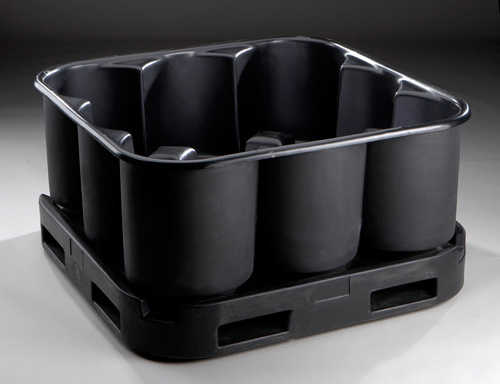
Polyethylene rotational molding can use either linear low-density polyethylene (LLDPE) or high-density polyethylene (HDPE) to produce strong, hollow parts for indoor and outdoor applications. LLDPE and HDPE are similar in terms of chemical composition but have some important differences when it comes to performance properties. This Q&A from Gregstrom examines these two rotomolding materials.
How are LLDPE and HDPE rotationally molded?
LLDPE and HDPE use the same basic process during rotational molding. First, powdered plastic or plastic pellets are added to a metal mold. Next, the tool is rotated and heated so that the polyethylene softens to the point that it begins to coat the inside of the mold. While rotating, the tool is then cooled so that the plastic solidifies. Finally, the mold is opened and the rotomolded part is removed.
What are the advantages of LLDPE?
LLDPE has medium stiffness and high tensile strength, the maximum stress a material can withstand while being pulled or stretched before breaking. This polymer is durable but forgiving, and virgin LLDPE provides resistance to chemicals and environmental stress cracking. For outdoor applications, LLDPE can be enhanced with UV stabilizers and with anti-fungal or anti-microbial additives.
What are some applications for LLDPE?
Applications for rotomolded LLDPE include plastic tanks, buckets, bins, containers, toys, and outdoor recreational products and equipment. Because LLDPE can be blended with pigments, designers can achieve specific colors without parts painting.
What are the advantages of HDPE?
HDPE has high tensile strength but is stiffer than LLDPE. In addition, HDPE has a slightly higher strength-to-density ratio. HDPE plastic is lightweight, impact-resistant, withstands most chemical solvents, and is non-leaching. Like LDPE, this form of polyethylene supports the addition of UV stabilizers and anti-fungal or anti-microbial additives.
What are some applications for HDPE?
High-density polyethylene (HDPE) can support complex designs and large rotomolded products, such as those used by the food processing industry. Special HDPE grades can meet FDA and USDA requirements. Because of its performance properties, HDPE is a better choice for some plastic tanks and for products such as boat docks and underground vessels.
Who provides polyethylene rotational molding for LLDPE and HDPE?
Gregstrom provides LLDPE and HDPE rotational molding that adds value to your projects. For over 75 years, we’ve been the Made in USA plastics manufacturer that more customers trust. In addition to rotomolding, we offer design assistance, tooling, robotic and CNC finishing, assembly and testing, and quality assurance. To get started with polyethylene rotational molding, contact us.
